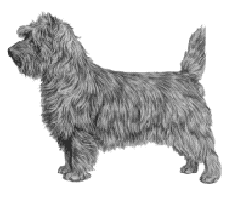Cairn Terrier
General Information - Cairn Terrier

Group:
Terrier
Size:
small
Lifespan:
12-15 years
Exercise:
moderate
Grooming:
moderate
Trainability:
very hard
Watchdog ability:
very high
Protection ability:
low
Area of Origin:
Scotland
Date of Origin:
Middle Ages
Other Names:
none
Original Function:
killing vermin
History
This dog, known since 1500, was first publicly presented in 1909 and became popular after 1930. The Cairn is one of Scotland's original Terriers, probably a contributor to today's Scottish, West Highland White and Skye terrier breeds. Named for the piles of small stones used to mark Scottish farm borders and graves, the Cairn Terrier’s job was to rout small animals from their lairs in these stone piles. Though used for such purposes for centuries, the Cairn Terrier is now primarily a companion dog. He also excels at Terrier (Go-To-Ground) trials. Everyone remembers a Cairn called "Toto" in the film "The Wizard of Oz."
Temperament
The Cairn is the essence of terrier; plucky, spirited, bold, inquisitive, hardy, clever, stubborn and scrappy. It is responsive to its owner's wishes, however, and tries to please; in fact, it is surprisingly sensitive. The Cairn Terrier is a self-assured and alert dog breed who makes a good watchdog. Affectionate and loving, the Cairn Terrier is naturally patient with children.
Upkeep
Despite its small size, the Cairn needs outdoor exercise every day, either a moderate walk on leash, a fun game in the yard or an excursion in a safe area. It can live outdoors in temperate climates, but it does better sleeping indoors. Its wire coat needs combing once weekly, plus stripping of dead hair at least twice yearly.
Cairn Terrier
A breed standard is the guideline which describes the ideal characteristics, temperament, and appearance of a breed and ensures that the breed is fit for function with soundness essential. Breeders and judges should at all times be careful to avoid obvious conditions and exaggerations, as well as being mindful of features which could be detrimental in any way to the health, welfare or soundness of this breed.
Breed Standard - Cairn Terrier
 Characteristics
Characteristics: Should impress as being active, game and hardy.
General Appearance: Agile, alert of workmanlike, natural appearance. Weather:resistant coat.
Temperament: Fearless and gay disposition; assertive but not aggressive.
Head and Skull: Head small, but in proportion to body. Skull broad, a decided indentation between the eyes with definite stop. Muzzle powerful, jaw strong but not long or heavy. Nose black. Head well furnished.
Eyes: Wide apart, medium in size, dark hazel. Slightly sunk with shaggy eyebrows.
Ears: Small, pointed, well carried and erect, not too closely set nor heavily coated.
Mouth: Large teeth. Jaw strong with perfect, regular and complete scissor bite, i.e. upper teeth closely overlapping lower teeth and set square to jaws.
Neck: Well set on, not short.
Forequarters: Sloping shoulders, medium length of leg; good, but not too heavy bone. Forelegs never out at elbow. Legs covered with harsh hair.
Body: Back level, medium in length. Well sprung deep ribs; strong supple loin.
Hindquarters: Very strong, muscular thighs. Good, but not excessive bend of stifle. Hocks well let down, inclining neither in nor out when viewed from the rear.
Feet: Forefeet, larger than hind, may be slightly turned out. Pads thick and strong. Thin, narrow or spreading feet and long nails objectionable.
Tail: Short, balanced, well furnished with hair, but not feathery. Neither high or low set, carried gaily but not turned down towards back.
Gait: Very free:flowing stride. Forelegs reaching well forward. Hind legs giving strong propulsion. Hocks neither too close nor too wide.
Coat: Very important. Weather resistant. Must be double:coated, with profuse, harsh, but not coarse outer coat; undercoat short, soft and close. Open coats objectionable. Slight wave permissible.
Colour: Cream, wheaten, red, grey or nearly black. Brindling in all these colours acceptable. Not solid black or white, or black and tan. Dark points, such as ears and muzzle, very typical.
Size: Height approximately 28: 31 cm (11:12 in) at withers but in proportion to weight
-
ideally 6: 7.5 kg (14:16 lbs).
Faults: Any departure from the foregoing points should be considered a fault and the seriousness of the fault should be in exact proportion to its degree.
Note: Male animals should have two apparently normal testicles fully descended into the scrotum.
DNZ No 228
Copyright Dogs New Zealand
01 Jan 2002
Any departure from the foregoing points should be considered a fault and the seriousness with which the fault should be regarded should be in exact proportion to its degree and its effect upon the health and welfare of the dog and on the dog’s ability to perform its traditional work.




